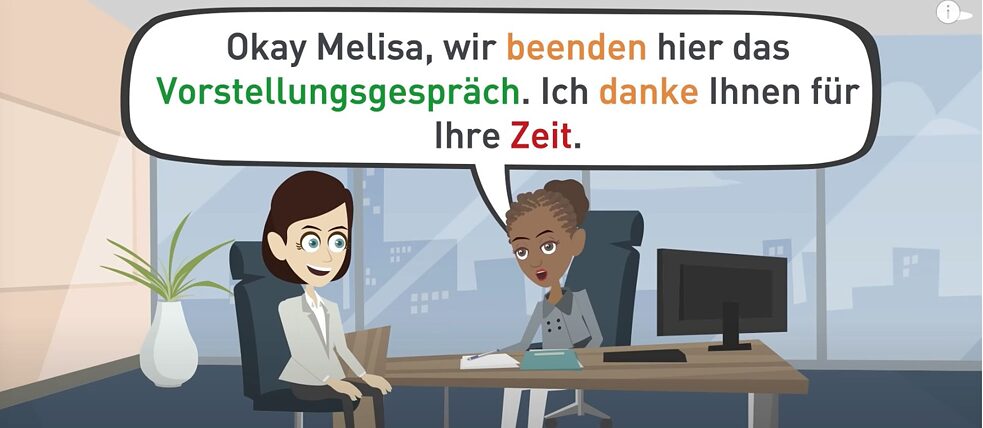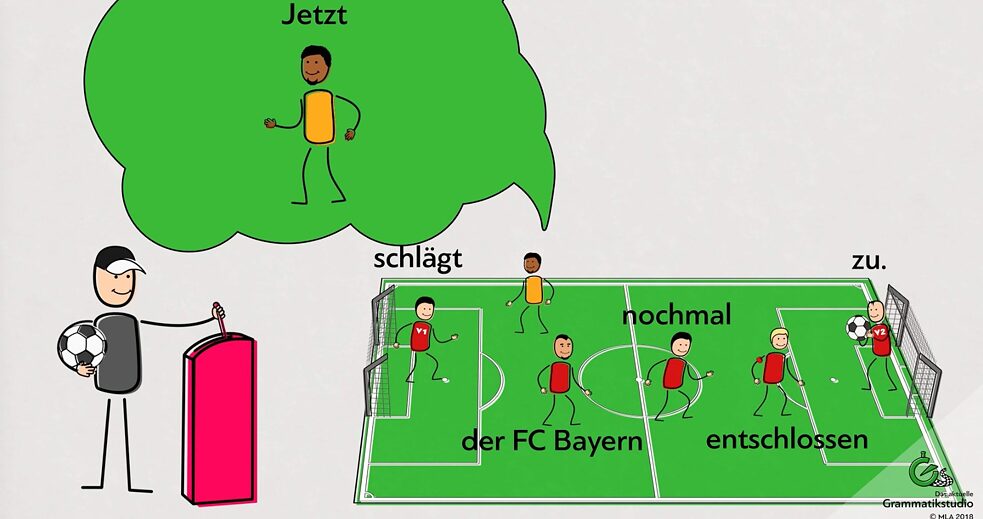Language learning with video
Using video in modern-day foreign language teaching

© Adobe Stock
Is every video suitable for the reception of multimodal texts in a foreign language? What types of video are currently being produced for use in teaching German? This article provides a brief outline of videos most widely used in German teaching and a look at the multimodal presentation of video content.
By Dr. Zuzana Münch-Manková and Juliane-Nicola Müller de Acevedo
Changes in learning culture
In the wake of the transition to a new learning culture, some learners themselves are demanding that more digital media be worked into foreign language instruction (Ende 2014: 42). Videos seem to be an ideal way of bringing authentic (foreign) language into the classroom and providing insight into current usage. Learners can now access countless videos on their own on commercial platforms like YouTube, as well as on individual teachers’ private platforms and educational servers and in media libraries. Language learning videos are geared to meet learners' communication needs and to train their language skills. Depending on the area of competence targeted (reception, production, interaction, mediation), the videos use subtitles, speech balloons and/or fill-in-the-blanks reading comprehension exercises, for example, to steer and support the learners' attention. Based on our analysis of the literature in this field and our own Internet research, the video-based approaches used for language teaching for different age groups can be broken down into the following formats:1. Listen-and-repeat dialogue videos
2. Text-based videos according to subject matter
3. Grammar animations
4. Explainer videos
5. Gaming and game-based videos
Listen-and-repeat dialogue videos
Listen-and-repeat dialogue videos involve listening to and repeating the most important phrases in situational contexts (daily routine, introducing oneself, at a café). Learners can repeat the everyday stories and conversations acted out in the videos ad libitum. The target group comprises A1–A2 level learners, though there are playlists for more advanced levels, too. These videos, which are generally produced by language schools or teachers of German as a foreign language, are integrated into learning management systems or blogs, or provided as supplements to existing material. Most of the dialogue-based videos on the YouTube channel of the Swiss Hallo Deutschschule. Deutsch lernen mit Dialogen are produced in comic or cartoon format. The dialogue situations are produced in the style of drawings, i.e. drawn digitally or by hand and filmed or generated using an animation program. Additional grammatical phenomena, such as case declension, are colour-coded in speech bubbles in animated dialogues. Job interview learning video
| © Hallo Deutschschule
Learners can train in handling professional and everyday situations as well as in ordinary small talk on the LinguaTV platform, for example. Each lesson comes with an accompanying video: as a rule, real-life scenes are filmed (live-action format) and followed up by speaking prompts and anticipation exercises (i.e. what happens next?).
Job interview learning video
| © Hallo Deutschschule
Learners can train in handling professional and everyday situations as well as in ordinary small talk on the LinguaTV platform, for example. Each lesson comes with an accompanying video: as a rule, real-life scenes are filmed (live-action format) and followed up by speaking prompts and anticipation exercises (i.e. what happens next?).
Topical text-based videos and grammar animation
The Deutschlernerblog für Deutschlerner in aller Welt (blog for German learners around the world) provides topic- and text-based videos. They are usually conventional slidecasts based on screenshots of presentations using transparencies. Whilst the texts are read aloud in the video, grammatical structures are highlighted to draw attention to them.The interactive platform Das Aktuelle Grammatikstudio gives research-based presentations of grammatical phenomena at A1–B2 level. The approach uses cognitive grammar and vivid animation to help users understand grammatical phenomena (Roche/EL-Bouz 2018). Since animated images have come to be regarded as the Esperanto of the digital realm, syntactic rules are presented tacitly using the football metaphor, with verbs, for example, playing the part of goalkeepers.
 Learning video with grammar animation
| Das aktuelle Grammatikstudio © MLA 2018
Learning video with grammar animation
| Das aktuelle Grammatikstudio © MLA 2018
Explainer videos
Generally speaking, explainer videos for German language learners are personal videos in vlogging style (Wolf 2020) in which the teacher speaks directly into the camera, explaining and visualizing language patterns and providing links, tips and exercises for practice purposes. Sofatutor, the most well-known German tutoring platform, also offers language-learning content in conventional table-top videos that correspond to standard school curricula and to pupils’ interests and language levels. In table-top explainer videos, drawn elements are placed under the camera one at a time and explained by a voiceover.Game-based videos
Playful language-learning videos range from privately made, interactive PowerPoint-based videos for the purpose of memorizing vocabulary to so-called “serious games” and “Second Life” learning with avatars. Low-cost variants include “memory videos” on teachers' private channels. After listening attentively, learners try to repeat the right word for a picture on a card, which is then placed face down again as in the “Memory” game. At the other end of the spectrum are interactive adventure games, in which the gamer follows a character who discovers a hitherto unknown city, clears up a mystery or has to solve a problem. The Goethe-Institut’s detective game Ein rätselhafter Auftrag (A Mysterious Case) is a case in point. Deutsche Welle has created a cheeky character named Harry, who needs the learner’s help to break out of a time loop. The language skills required for such stories told virtually can be applied to real-life situations. To help the protagonists, not only do learners have to make use of contextually appropriate vocabulary, they also have to read and/or write various types of text that are likely to prove useful in everyday life as well, e.g. e-mails, job applications and CVs. As a result, this approach intertwines elements of gaming with exercises on German vocabulary and culture. Gabriel (2016) has compiled studies on the pros and cons of using computer games to teach German as a foreign/second language. They improve learners’ skills in lexis, discursive strategies and grammatical structures as well as in social, cultural and Germany-related aspects. Learning success depends on several factors: in addition to those of time, the didactic embedding of videos and the use of supporting exercises before, during and after a video, target group appropriateness (e.g. suitability of games for second-language acquisition) is another key factor. Authentic contexts, the “fun” factor, interactivity and feedback within the game are crucial for sustaining learners’ motivation.References
- Ende, Karin (2014): “Motivation durch digitale Medien im Unterricht? Aber ja!” In: Fremdsprache Deutsch. Zeitschrift für die Praxis des Deutschunterrichts, 51, 42–48.
- Gabriel, Sonja (2016): “Spielend Fremdsprachen lernen – Wie können digitale Spiele den Fremdsprachenerwerb unterstützen? Eine kurze Übersicht über den derzeitigen Stand der Forschung”. In: Medienimpulse. 54 (3). Online: https://journals.univie.ac.at/index.php/mp/article/view/mi973 (29 Jan. 2021).
- Roche, Jörg; EL-Bouz, Katsiaryna (2018): “Deutsche Grammatik sportlich und animiert”. In: Zeitschrift für Interkulturellen Fremdsprachenunterricht, 23 (1), 30‒42.
- Wolf, Karsten D. (2020): “Sind Erklärvideos das bessere Bildungsfernsehen”? In: Dorgerloh, Stephan; Wolf, Karsten D. (eds.): Lehren und Lernen mit Tutorials und Erklärvideos. Weinheim (Germany)/Basel: Beltz, 17–24.
Links
- Hallo Deutschschule. Deutsch lernen mit Dialogen: https://www.youtube.com/channel/UC5ZnpdkQIit8TWhGVDiDnQQ
- LinguaTV: www.linguatv.com
- Deutschlernerblog für Deutschlerner in aller Welt: https://deutschlernerblog.de/deutschlerner-aus-aller-welt-schreiben/
- Das Aktuelle Grammatikstudio: https://granima.de
- Sofatutor: https://www.sofatutor.com/
- Ein rätselhafter Auftrag: https://www.youtube.com/watch?v=6QNILkB5wYE
- Harry: https://www.dw.com/de/deutsch-lernen/harry/s-13219
Authors
Dr. Zuzana Münch-Manková is a postdoc in the field of DaZ/DaF at the University of Oldenburg with a focus on "linguistic and subject learning" within the Research Academy. Her research focuses on digitally supported language-sensitive subject teaching, German as a second language and multilingualism in subject contexts, professionalization research, and in-service training formats for DaZ and DaF teachers.Juliane-Nicola Müller de Acevedo is an expert on teaching and head of the PASCH initiative - "Schools: Partners for the Future" for the Goethe-Institut in Brazil. Her research focuses on literacy promotion in multilingual contexts, in-service didactics, language diagnostics, and intercultural encounters in the digital space.